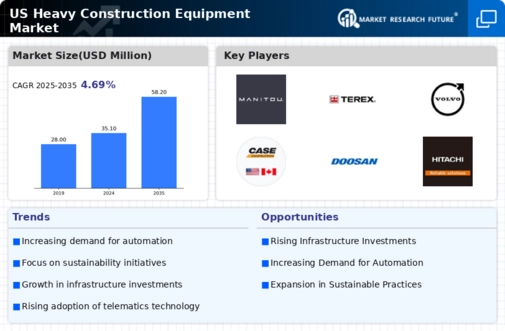Rising Urbanization
The heavy construction-equipment market is experiencing a notable surge due to increasing urbanization across the United States. As cities expand and populations grow, the demand for infrastructure development intensifies. This urban growth necessitates the construction of residential, commercial, and public facilities, thereby driving the need for heavy construction equipment. According to recent data, urban areas are projected to house approximately 90% of the US population by 2050, which could lead to a substantial increase in construction activities. Consequently, manufacturers of heavy construction equipment are likely to see heightened demand for their products, as construction companies seek to invest in advanced machinery to meet the needs of urban development. This trend underscores the critical role that heavy construction equipment plays in shaping the future of urban landscapes.
Environmental Regulations
The heavy construction-equipment market is also being shaped by stringent environmental regulations aimed at reducing emissions and promoting sustainability. In the US, regulatory bodies are implementing stricter guidelines for construction equipment emissions, compelling manufacturers to innovate and produce cleaner, more efficient machinery. The Environmental Protection Agency (EPA) has established standards that require construction equipment to meet specific emissions criteria, which has led to a growing demand for eco-friendly alternatives. As a result, companies in the heavy construction-equipment market are likely to invest in research and development to create equipment that complies with these regulations while maintaining performance. This shift towards greener technology not only addresses regulatory requirements but also aligns with the increasing public demand for sustainable construction practices.
Technological Integration
The integration of advanced technologies into the heavy construction-equipment market is reshaping the industry landscape. Innovations such as telematics, automation, and artificial intelligence are enhancing the efficiency and productivity of construction operations. For example, telematics systems allow for real-time monitoring of equipment performance, leading to improved maintenance schedules and reduced downtime. As construction companies increasingly adopt these technologies, the demand for modern heavy construction equipment equipped with such features is likely to rise. This trend suggests that manufacturers who invest in technological advancements may gain a competitive edge in the market. Furthermore, the heavy construction-equipment market could see a shift towards more sophisticated machinery that not only meets regulatory standards but also enhances operational efficiency.
Economic Recovery and Growth
The heavy construction-equipment market is poised for growth as the US economy continues its recovery trajectory. Economic indicators suggest a rebound in construction activities, driven by increased consumer confidence and business investments. As companies expand their operations and new projects are initiated, the demand for heavy construction equipment is expected to rise. According to forecasts, the construction sector is projected to grow at a CAGR of approximately 5% over the next few years, which could translate into significant opportunities for equipment manufacturers. This economic growth may lead to heightened competition among construction firms, prompting them to invest in advanced machinery to enhance productivity and efficiency. Consequently, the heavy construction-equipment market is likely to benefit from this positive economic environment, fostering innovation and expansion within the industry.
Government Infrastructure Programs
Government initiatives aimed at enhancing infrastructure are significantly influencing the heavy construction-equipment market. The US government has allocated substantial funding for various infrastructure projects, including roads, bridges, and public transportation systems. For instance, the Infrastructure Investment and Jobs Act, enacted in 2021, earmarked $1.2 trillion for infrastructure improvements over several years. This influx of capital is expected to stimulate demand for heavy construction equipment as contractors and construction firms ramp up their operations to fulfill government contracts. The heavy construction-equipment market stands to benefit from these programs, as they create a favorable environment for investment in new machinery and technology. As a result, the market is likely to witness growth driven by increased procurement of heavy equipment to support these large-scale projects.
























Leave a Comment